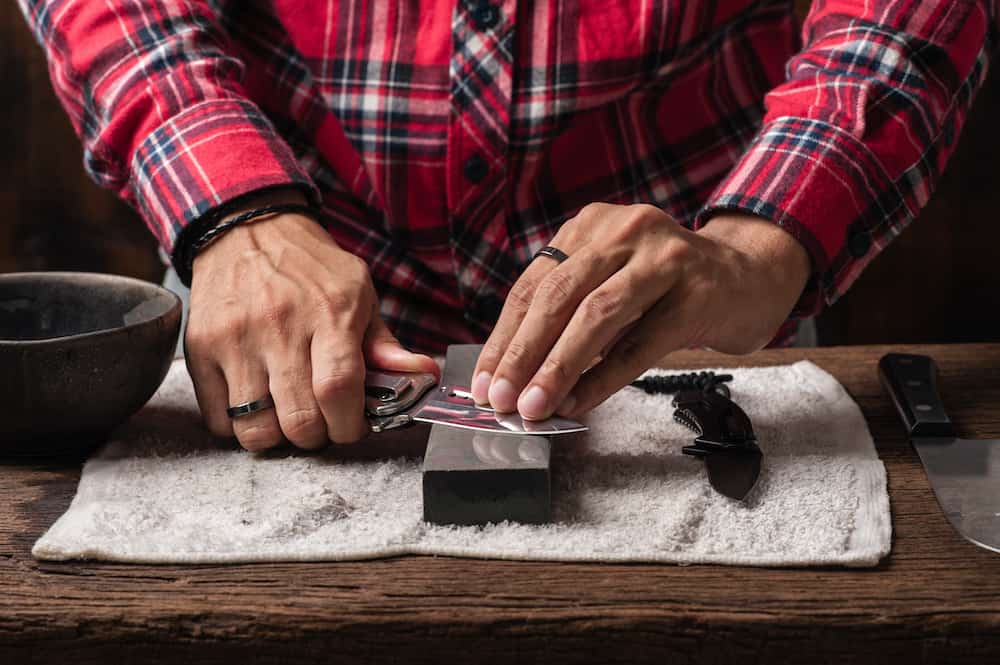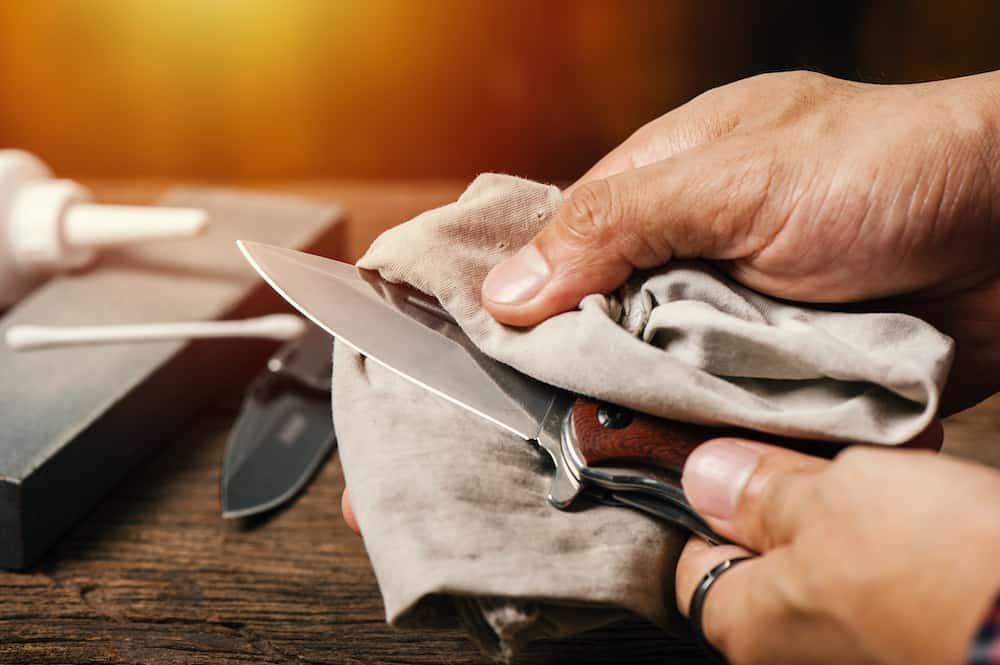Here I explain how to sharpen a knife, both with a sharpening tool and in a pinch, using a natural stone. Whether you’re cleaning wild game, preparing food, or facing an emergency situation, a sharp knife is an essential tool.
Remember to use protective eyewear and leather gloves for protection.
Why a Sharp Knife Matters
A sharp knife is safer to use (dull knives are more likely to slip and cause injury) and also cuts cleaner, more efficiently, and with less effort. This makes food preparation easier, reduces food waste, and minimizes strain and fatigue while using the knife.
Best Way to Sharpening a Knife: Sharpening Tools
While you can improvise in an emergency using a natural stone, the best way to sharpen a knife is with a sharpening tool. These come in various forms, each with its own advantages and learning curve:
- Whetstone: A good option for beginners due to its margin for error. Requires soaking before use and applying oil during sharpening.
- Diamond stone: Harder stone for more experienced users. Removes metal quickly and demands precise angle control.
- Ceramic stone: Similar to the diamond stone, it’s also hard and requires precise technique. A good choice for those comfortable with sharpening and desiring a durable stone.
Choosing the Right Tool
Consider these factors when choosing a sharpening tool:
- Your skill level: Start with a whetstone if you’re new.
- Frequency of use: If you sharpen often, a diamond or ceramic stone might be suitable once you gain experience.
- Budget and maintenance: Whetstones are generally more affordable but require more maintenance (soaking and oiling). Diamond and ceramic stones are typically more expensive but require less maintenance.
How to Sharpen a Knife with a Sharpening Tool
1. Clean the tool: Wash the sharpening tool with warm water and a sponge before each use to remove any built-up residue.
2. Prepare the tool (if necessary): Depending on the type of tool, you might need to soak it (whetstone) or apply oil (whetstone, diamond stone).
3. Stabilize the tool: Place the tool on a secure surface and use a damp cloth or a dedicated holder to prevent it from moving during sharpening.
4. Maintain the angle: Hold the knife at the correct angle (typically 15 – 20 degrees) against the sharpening tool and maintain consistent pressure as you draw the blade across the surface.
5. Repeat for both sides: Alternate strokes on both sides of the blade until the desired sharpness is achieved. Be mindful of the number of strokes to avoid over-sharpening.
Sharpening with a Natural Stone (Emergency Use Only)
Important note: This is a temporary solution and should not be used regularly. Natural stones can be uneven and cause uneven sharpening or damage the blade. It’s highly recommended to use a proper sharpening tool for optimal results and to maintain the integrity of your knife.
1. Choose the right stone: Look for a smooth, fine-grained stone with no large cracks or pits.
2. Hold the stone securely: Find a safe and stable position to hold the stone firmly. Inspect the ground to be sure you have good footing.
3. Sharpen the knife: Maintain the correct angle and use a gentle back-and-forth motion to sharpen the blade. Avoid applying excessive pressure to prevent damaging the stone or the blade.

Additional Tips
- Start with a duller blade: If you’re new to sharpening, practice on a less valuable knife first.
- Use light and even pressure: Avoid applying excessive pressure; this can damage the blade.
- Be safe: Always wear cut-resistant gloves and exercise caution while handling sharp knives.
- Get professional sharpening occasionally: Even with regular maintenance, knives eventually require professional sharpening to restore their original edge and maintain their longevity.
FAQs
How often should I sharpen my knives?
This depends on how often you use them and what you use them for. Generally, home cooks might need to sharpen their knives every few months, while professional chefs might need to do it weekly or even more frequently.
Can I sharpen serrated knives?
Sharpening serrated knives is a more advanced technique that requires a special sharpening tool. It’s generally recommended to take serrated knives to a professional sharpener.
What are some signs that my knife needs sharpening?
- It requires more force to cut through food.
- The food tears instead of slicing cleanly.
- The knife slips while cutting.
Knife Sharpening
By following these tips and choosing the right method for your situation, you can keep your knives sharp and safe to use.
A sharp knife is a valuable tool and also a safer and more enjoyable one to use in the kitchen or outdoors. A dull or unsharpened knife is useless and can be dangerous. It won’t let you handle everything you might encounter while you’re out in nature.
Having the right tool for handling wild game and fish is important. Start with a whetstone, and once you get good at using it, you can move to the harder stones to test your accuracy. Although the best way to sharpen a knife is with a stone sharpening tool, you can always use stones you’ll find in nature during emergencies such as when you need to build a temporary shelter, cut through bushes, and more.
Additional resources:
Additional reading:

